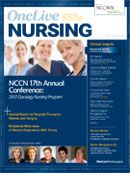Challenges With Managing Oral Cancer Treatments
Although oral treatments have revolutionized cancer care, their use presents challenges to both patients and providers.
Peg Esper, MSN, RN, AOCN®, ANP-BC
Although oral treatments have revolutionized cancer care, their use presents challenges to both patients and providers. Peg Esper, MSN, RN, AOCN®, ANPBC, an adjunct clinical instructor at the University of Michigan Comprehensive Cancer Center in Ann Arbor, discussed the management of oral oncolytic treatment at the 2012 NCCN Annual Meeting.
Oral agents provide a variety of benefits versus standard infusion chemotherapy. For patients, self-administering treatment is empowering and the reduction in clinic visits is less disruptive on their career and personal life. For providers, oral treatments offer greater flexibility to modify or stop treatment during a cycle in order to control side effects. These benefits are mitigated by several challenges, including financial strain, patient education challenges, patient compliance issues, and toxicity management.
According to Esper, the high cost of oral oncology agents is a problem for many patients who either have issues with coverage or steep copays. Additionally, many patients have to deal with the Medicare Part D coverage gap or “donut hole.” While some states have laws requiring equal coverage for intravenous and oral agents, most states lack such policies. To address these financial issues, most oral drug manufacturers offer patient-assistance programs.
Oral oncology agents also create educational challenges, as patients must fully comprehend how to administer and manage their own treatment. Each agent has unique side effects that need to be monitored, and patients need to know when it is necessary to call their healthcare provider or seek emergency care.
Even with comprehensive patient education, other issues interfere with successful management of oral agent toxicities. The reduction in clinical visits affords less time to monitor patients. This means an enhanced reliance on patient reporting, which is often incomplete regarding toxicities experienced between cycles of therapy. According to Esper, there are also logistical issues in the clinical setting. Some of the nursing staff may not see patients given prescriptions for oral agents during a clinic visit. Additionally, patient education visits may not be scheduled before treatment begins.
Relying on patients to self-deliver care also creates adherence issues with oral oncolytics. Some of the factors that impact adherence include cognitive issues, depression, lack of support, a lack of belief in treatment value, and financial concerns. According to Esper, “over-adherence” is just as problematic as “under-adherence,” as some patients think higher doses will enhance and quicken the treatment.
Esper recommended several strategies for improving treatment with oral agents, including increasing clinical visits at the start of treatment, offering phone support, prescribing no more than one cycle of therapy, advising patients to keep diaries or logs, and providing educational materials for symptom management strategies.

Innovative Program Reduces Nurse Turnover and Fosters Development
Published: September 12th 2024 | Updated: September 12th 2024The US Oncology Network (The Network) has developed one of the most comprehensive programs in the nation to support the professional development and retention of new oncology nurses.



